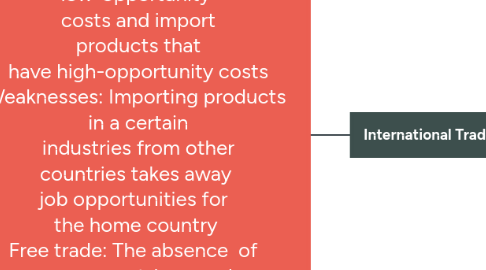
1. International Trade Theory
1.1. New Trade Theory
1.1.1. Theory predicts that nations are home to firms that gained first move advantage in a certain products may have an advantage
1.1.1.1. Economies of Scale: unit cost reduction associated with large scale of output
1.2. Mercantilism
1.2.1. Economic philosophy advocating that countries should smultaneously encourage exports and discourage imports
1.2.1.1. Government used their economies to encourage state power at the expense of other countries by ensuring ensure that exports exceeded imports and to accumulate wealth in the form of bullion (mostly gold and silver).
1.3. Adam Smith' Theory of Absolutely Advantage
1.3.1. When one country is more efficient than any other country in producing a particular product
1.3.1.1. Practice by which countries can gain from trade by specializing in producing and exporting the goods that they produce and import products that are more efficient in other countries
1.4. David Ricardo's Theory of Comparative Advantage
1.4.1. When one country specializes in the production of goods they can produce more efficiently compared to other countries
1.4.1.1. If a country enters into a free trade agreement with a poor country that rapidly improves it productivity after the introduction of a free trade regime, the lower the prices the rich country's consumers pay for the imported goods from the poor country may not be enough to produce a net gain for the rich country's economy if dynamic of free trade is to lower real wage rates in the rich country
1.5. Raymond Vernon's Product life cycle Theory
1.5.1. Argues a firm should establish production facilities in the other areas where there are low labor costs compared to home country and export to other regions. When demand for a new product in other countries becomes significant, it becomes worthwhile for innovating firm to set up production facilities in those countries
1.5.1.1. Theory suggest that every product has its own lifespan and goes through various stages from introduction to decline.
1.6. Heck scher-Ohlin Theory
1.6.1. Predicts countries will export those goods that make extensive use of factors that are locally abundant while importing goods and that make intensive use of factors that are locally scarce
1.6.1.1. Model helps country to predict patterns of trade between low- and high-income countries
1.7. Porter's Diamond of National Competitive Advantage
1.7.1. Argues four broad attributes of nation that shape the enviroment in which local firms competes and these attributes promote or impede the creation of competitive advantage
1.7.1.1. Factor Endowments
1.7.1.1.1. A nation's position in factors of production has skilled labor or the infrastructure necessary to compete in an industry
1.7.1.2. Demand Conditions
1.7.1.2.1. The nature of home demand for the industry's product or service
1.7.1.3. Firm Strategy, Structure, and Rivalry
1.7.1.3.1. The condition governing how companies are created, organized and managed and the nature of domestic rivalry
1.7.1.4. Relating and Supporting Industries
1.7.1.4.1. The presence of absent of supplier industries and related industries that are internationally competitive
